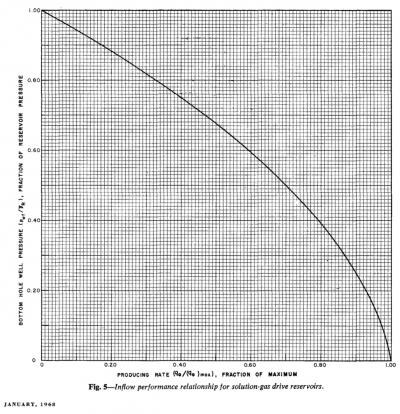Difference between revisions of "Vogel's IPR"
From wiki.pengtools.com
(→Vogel's Inflow Performance Relationship) |
(→Vogel's Inflow Performance Relationship) |
||
| Line 6: | Line 6: | ||
[[Vogel's IPR]] is based on computer simulations to several solution gas drive reservoirs for different fluid and reservoir relative permeability properties. | [[Vogel's IPR]] is based on computer simulations to several solution gas drive reservoirs for different fluid and reservoir relative permeability properties. | ||
| − | |||
| − | |||
| − | |||
| − | |||
==Math and Physics== | ==Math and Physics== | ||
Revision as of 08:11, 5 April 2019
Contents
Vogel's Inflow Performance Relationship

Vogel's IPR[1]
Vogel's IPR is an empirical two-phase (oil + gas) inflow performance relationship correlation published in 1968 [1].
Vogel's IPR is based on computer simulations to several solution gas drive reservoirs for different fluid and reservoir relative permeability properties.
Math and Physics
Oil well IPR equation
- Darcy's law inflow equation for the single phase incompressible liquid:
- Vogel's IPR two phase equation (oil + gas) and it's combination with single phase liquid
- Composite IPR three phase equation (oil + gas + water)
Gas well IPR equation
- Darcy's law gas inflow equation:
- C and n equation
IPR calculator software
- PQplot nodal analysis software is used to calculate the IPR curves. PQplot is available online at www.pengtools.com.
- Excel
- other
Nomenclature
 = formation volume factor, bbl/stb
= formation volume factor, bbl/stb = dimensionless productivity index, dimensionless
= dimensionless productivity index, dimensionless = permeability times thickness, md*ft
= permeability times thickness, md*ft = average reservoir pressure, psia
= average reservoir pressure, psia = average reservoir pseudopressure, psia2/cP
= average reservoir pseudopressure, psia2/cP = well flowing pressure, psia
= well flowing pressure, psia = average well flowing pseudopressure, psia2/cP
= average well flowing pseudopressure, psia2/cP = flowing rate, stb/d
= flowing rate, stb/d = gas rate, MMscfd
= gas rate, MMscfd = temperature, °R
= temperature, °R
Greek symbols
 = viscosity, cp
= viscosity, cp


